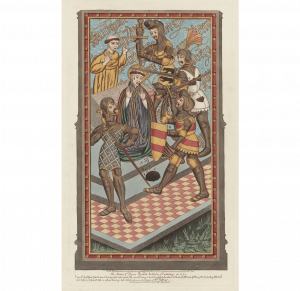by Bethany Scard
2020 marks the 850th anniversary of the death of Thomas Becket and the 800th anniversary of moving his body to his new shrine in Canterbury. Not many people have two anniversaries to celebrate like this, so you can already tell he’s an important man.
In her talk to the City of Lincoln branch of the Historical Association Professor Philippa Hoskin of the University of Cambridge on Monday 3rd February, described Becket as a medieval ‘superstar saint’, the Robin Hood of his century and the hero of the people. He was also referred to as a Jedi knight which peaked my interest because you don’t come across many Jedi’s in the church.
So who is Thomas Becket? What makes him so special that he could be a Jedi?
Professor Hoskin explained his life story and why he is important today. Why 800 years on, his life is still being celebrated with a magnificent exhibition in the British Museum in London, starting this October. The exhibition will present Becket alongside all the major physical items associated with his life and his legend, collected from all around the world. A once in a lifetime opportunity, according to Professor Hoskin, so get yourselves down to London this autumn.
And now, the story.
Thomas Beckett and the murder in the museum.
Or should I say cathedral.
Becket was an ordinary man. He worked hard alongside his good friend Henry (soon to be King Henry II). The two men worked tirelessly to bring law and order to the land, this is where processes like trial-by-jury came about.
When the previous Archbishop of Canterbury passed away in 1162, Henry saw his chance to promote his friend. However, Becket’s behaviour changed with his new position. He now had a higher purpose. He began to wear a sackcloth shirt, and only drank water and limited his diet.
Becket and Henry began to clash with their different views, Becket believed that the church was above the law of land. Above the King. The close friendship that these two men shared had ended.
Henry let his emotions get the best of him when he was overheard saying “will no one rid me of this turbulent priest” after Becket excommunicated some of his fellow bishops in Canterbury, Christmas day 1170.
4 men took this literally. Not just a comment in the heat of the moment. They went and butchered Becket where he knelt, smashing his head in. Apparently, his brains were splattered over the steps of the cathedral.
And now Canterbury was faced with the big question.
What do you do with the dead body of an Archbishop in your cathedral?
No one had been murdered in a cathedral before, it was a sacred place, and Henry and his soldiers had defiled the sacred space. By trying to rid himself of a potential problem, Henry created an even bigger issue.
When an archbishop is struck down where he kneels to pray, defenceless, he becomes a martyr. Three years after his death Becket was canonised. He was now a Saint! And saints can talk to God. They have power in heaven that is beyond the king’s control. Therefore, Becket became more powerful in death, a true Jedi.
The cathedral in Canterbury become a hot spot for tourists. Many would come on pilgrimage to see where the saint was murdered and to leave offerings at his shrine. The love for this man grew over the years. The threat that he posed to the crown also grew.
The miraculous thing about being made into a saint is that your life suddenly becomes a lot more significant. Dr Hoskin talked about one manuscript that told the legend of Becket’s birth. He was no longer a man born to a London merchant, he was a son of a princess.
The legend goes that his mother, a Saracen princess, followed his father, a pilgrim, back from the Holy Land and wandered around Europe repeating the words “London” and “Becket” until she found him.
A man of such importance had to have an important birth.
Henry VIII was also mentioned by Professor Hoskin because the English Reformation saw acts of iconoclasm and a hatred for Becket. She referenced a book of bad poetry with any mention of Thomas Becket as a saint crossed out.
Professor Hoskin, however, pointed out that the person doing this must have gotten tired because half way through the book he stopped. And he did nothing to alter the actual legends surrounding Becket, so his attempt to hide the fact that Becket was saint was half-finished.
Professor Hoskin concluded her talk by explaining how Becket is still relevant today because his name and what he stands for is still important. So, if you have time, go and explore the British Museum to see all the relics and manuscripts that are related to Becket and embrace the story of the man murdered in the museum.
The Historical Association has another talk at 6pm on Monday 2nd March about Hitler’s Secret Agents: The Gestapo Spy Network, 1933-4. It will be an interesting talk given by Bishop Grosseteste University’s Claire Hubbard-Hall, so be sure to come along to the Nicola de la Haye building on the University of Lincoln campus to learn more.
Please visit our own blog page to find out more information about what we do and when: https://cityoflincolnbranchha.wordpress.com/
Also follow us on twitter to find out more, our username is: cityoflincolnha .

